check engine Citroen DS5 HYBRID4 RHD 2014 1.G Owner's Manual
[x] Cancel search | Manufacturer: CITROEN, Model Year: 2014, Model line: DS5 HYBRID4 RHD, Model: Citroen DS5 HYBRID4 RHD 2014 1.GPages: 382, PDF Size: 14.52 MB
Page 7 of 382
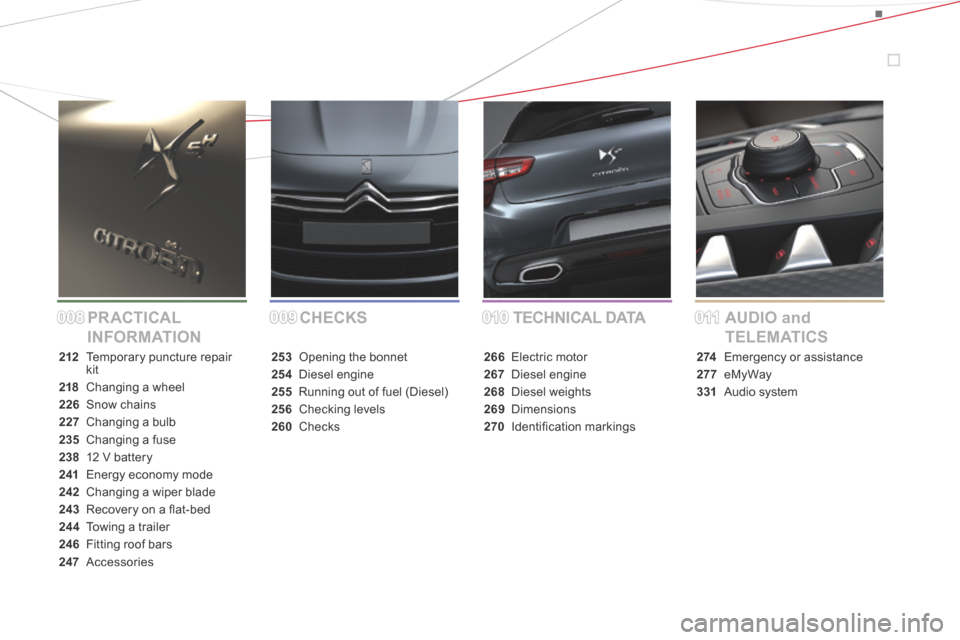
CHECKS
PR ACTICAL
INFORMATION TECHNICAL DATA
AUDIO and
TELEMATICS
212 Temporary puncture repair kit
218 Changing a wheel
226 Snow chains
227 Changing a bulb
235 Changing a fuse
238 12 V battery
241 Energy economy mode
242 Changing a wiper blade
243 Recovery on a fl at-bed
244 Towing a trailer
246 Fitting roof bars
247 Accessories
253 Opening the bonnet
254 Diesel engine
255 Running out of fuel (Diesel)
256 Checking levels
260 Checks
266 Electric motor
267 Diesel engine
268 Diesel weights
269 Dimensions
270 Identifi cation markings
2 74 Emergency or assistance
277 eMyWay
331 Audio system
0080090100 11
Page 11 of 382
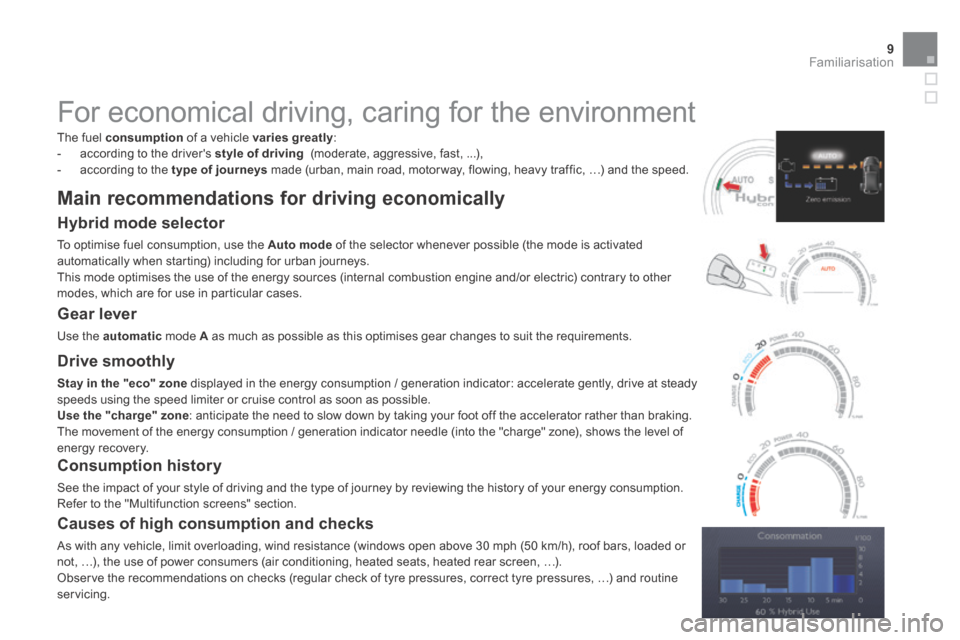
9Familiarisation
For economical driving, caring for the environment
The fuel consumption of a vehicle varies greatly : - according to the driver's style of driving (moderate, aggressive, fast, ...), - according to the type of journeys made (urban, main road, motor way, flowing, heavy traffic, …) and the speed.
Main recommendations for driving economically
Hybrid mode selector
To optimise fuel consumption, use the Auto mode of the selector whenever possible (the mode is activated automatically when starting) including for urban journeys. This mode optimises the use of the energy sources (internal combustion engine and/or electric) contrary to other modes, which are for use in particular cases.
Gear lever
Use the automatic mode A as much as possible as this optimises gear changes to suit the requirements.
Causes of high consumption and checks
As with any vehicle, limit overloading, wind resistance (windows open above 30 mph (50 km/h), roof bars, loaded or not, …), the use of power consumers (air conditioning, heated seats, heated rear screen, …). Observe the recommendations on checks (regular check of tyre pressures, correct tyre pressures, …) and routine servicing.
Drive smoothly
Stay in the "eco" zone displayed in the energy consumption / generation indicator: accelerate gently, drive at steady speeds using the speed limiter or cruise control as soon as possible. Use the "charge"zone: anticipate the need to slow down by taking your foot off the accelerator rather than braking. The movement of the energy consumption / generation indicator needle (into the "charge" zone), shows the level of energy recovery.
Consumption history
See the impact of your style of driving and the type of journey by reviewing the history of your energy consumption. Refer to the "Multifunction screens" section.
Page 37 of 382
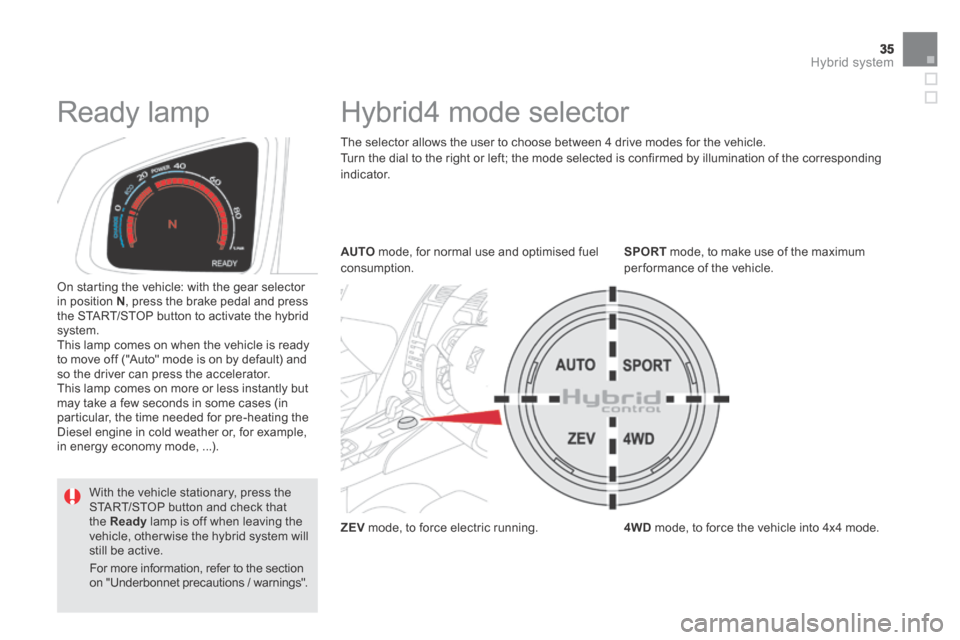
35Hybrid system
Hybrid4 mode selector
The selector allows the user to choose between 4 drive modes for the vehicle. Turn the dial to the right or left; the mode selected is confirmed by illumination of the corresponding i n d i c a t o r.
ZEV mode, to force electric running.
SPORT mode, to make use of the maximum per formance of the vehicle.
4WD mode, to force the vehicle into 4x4 mode.
AUTO mode, for normal use and optimised fuel consumption.
On starting the vehicle: with the gear selector in position N , press the brake pedal and press the START/STOP button to activate the hybrid system. This lamp comes on when the vehicle is ready to move off ("Auto" mode is on by default) and so the driver can press the accelerator. This lamp comes on more or less instantly but may take a few seconds in some cases (in particular, the time needed for pre-heating the Diesel engine in cold weather or, for example, in energy economy mode, ...).
Ready lamp
With the vehicle stationary, press the START/STOP button and check that the Ready lamp is off when leaving the vehicle, other wise the hybrid system will still be active.
For more information, refer to the section on "Underbonnet precautions / warnings".
Page 50 of 382
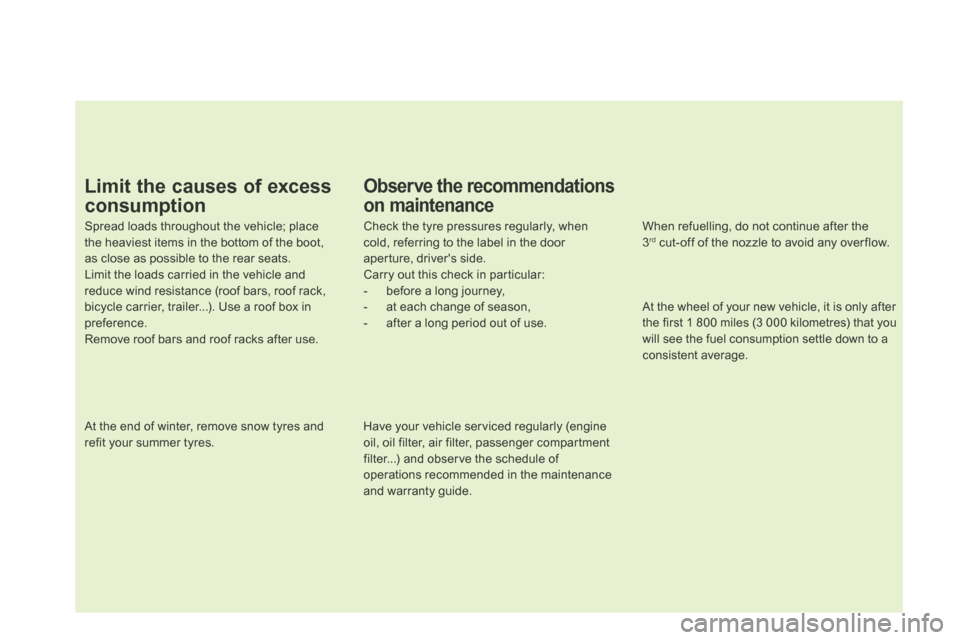
Observe the recommendations
on maintenance
Check the tyre pressures regularly, when cold, referring to the label in the door aperture, driver's side. Carry out this check in particular: - before a long journey, - at each change of season, - after a long period out of use.
Have your vehicle serviced regularly (engine oil, oil filter, air filter, passenger compartment filter...) and observe the schedule of operations recommended in the maintenance and warranty guide.
When refuelling, do not continue after the 3 rd cut-off of the nozzle to avoid any over flow.
At the wheel of your new vehicle, it is only after the first 1 800 miles (3 000 kilometres) that you will see the fuel consumption settle down to a consistent average.
At the end of winter, remove snow tyres and refit your summer tyres.
Spread loads throughout the vehicle; place the heaviest items in the bottom of the boot, as close as possible to the rear seats. Limit the loads carried in the vehicle and reduce wind resistance (roof bars, roof rack, bicycle carrier, trailer...). Use a roof box in preference. Remove roof bars and roof racks after use.
Limit the causes of excess
consumption
Page 56 of 382
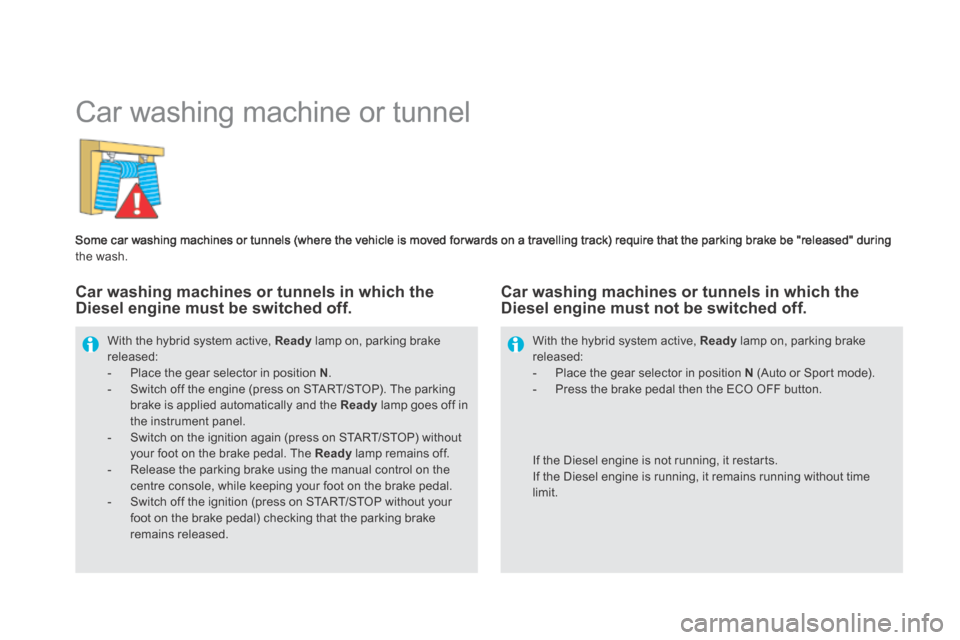
Car washing machine or tunnel
Some car washing machines or tunnels (where the vehicle is moved for wards on a travelling track) require that the parking brake be "released" during the wash.
With the hybrid system active, Ready lamp on, parking brake released: - Place the gear selector in position N . - Switch off the engine (press on START/STOP). The parking brake is applied automatically and the Ready lamp goes off in the instrument panel. - Switch on the ignition again (press on START/STOP) without your foot on the brake pedal. The Ready lamp remains off. - Release the parking brake using the manual control on the centre console, while keeping your foot on the brake pedal. - Switch off the ignition (press on START/STOP without your foot on the brake pedal) checking that the parking brake
remains released.
If the Diesel engine is not running, it restarts. If the Diesel engine is running, it remains running without time limit.
With the hybrid system active, Ready lamp on, parking brake released: - Place the gear selector in position N (Auto or Sport mode). - Press the brake pedal then the ECO OFF button.
Car washing machines or tunnels in which the Diesel engine must be switched off. Car washing machines or tunnels in which the Diesel engine must not be switched off.
Page 69 of 382
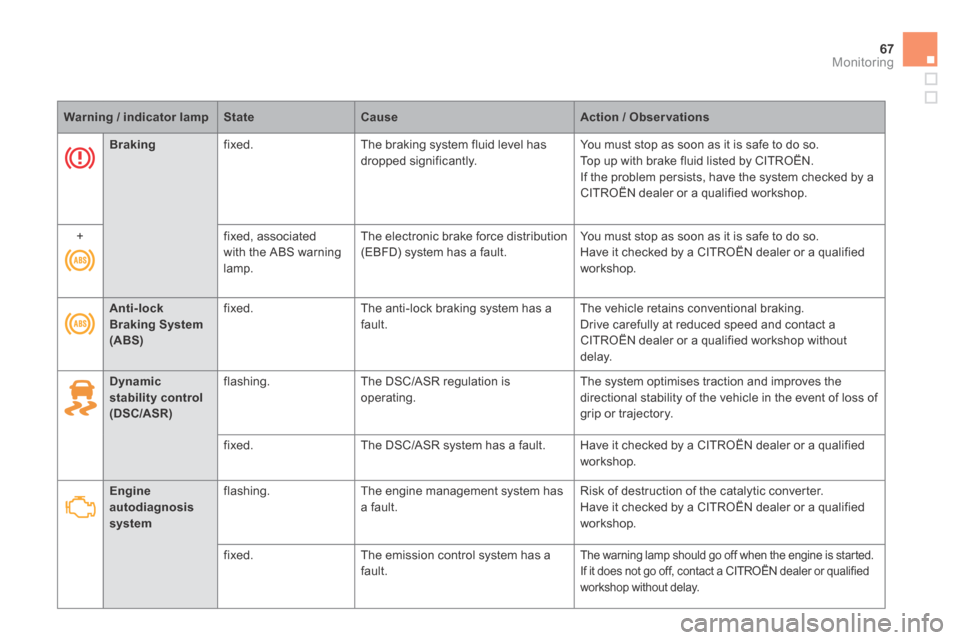
67Monitoring
Warning / indicator lampStateCauseAction / Observations
Dynamic stability control (DSC/ASR)
flashing. The DSC/ASR regulation is operating. The system optimises traction and improves the directional stability of the vehicle in the event of loss of grip or trajectory.
fixed. The DSC/ASR system has a fault. Have it checked by a CITROËN dealer or a qualified workshop.
Engine autodiagnosis system
flashing. The engine management system has a fault. Risk of destruction of the catalytic converter. Have it checked by a CITROËN dealer or a qualified workshop.
fixed. The emission control system has a fault. The warning lamp should go off when the engine is started. If it does not go off, contact a CITROËN dealer or qualified
workshop without delay.
Anti-lock Braking System (ABS)
fixed. The anti-lock braking system has a fault. The vehicle retains conventional braking. Drive carefully at reduced speed and contact a CITROËN dealer or a qualified workshop without d e l ay.
Braking fixed. The braking system fluid level has dropped significantly. You must stop as soon as it is safe to do so. Top up with brake fluid listed by CITROËN. If the problem persists, have the system checked by a CITROËN dealer or a qualified workshop.
+ fixed, associated with the ABS warning lamp.
The electronic brake force distribution (EBFD) system has a fault. You must stop as soon as it is safe to do so. Have it checked by a CITROËN dealer or a qualified workshop.
Page 71 of 382
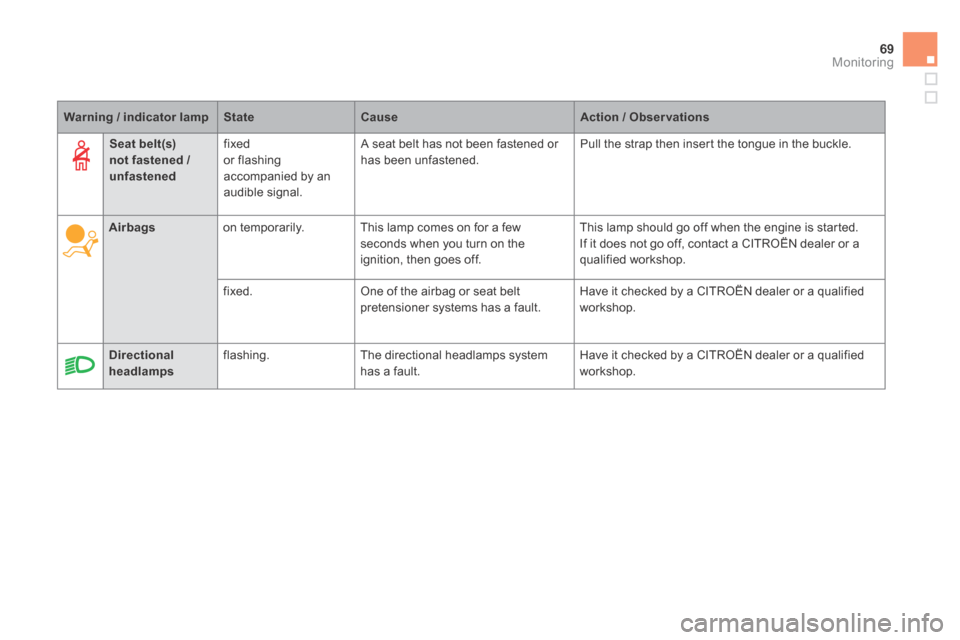
69Monitoring
Airbags on temporarily. This lamp comes on for a few seconds when you turn on the ignition, then goes off.
This lamp should go off when the engine is started. If it does not go off, contact a CITROËN dealer or a qualified workshop.
fixed. One of the airbag or seat belt pretensioner systems has a fault. Have it checked by a CITROËN dealer or a qualified workshop.
Directional headlamps flashing. The directional headlamps system has a fault. Have it checked by a CITROËN dealer or a qualified workshop.
Seat belt(s) not fastened / unfastened
fixed or flashing accompanied by an audible signal.
A seat belt has not been fastened or has been unfastened. Pull the strap then insert the tongue in the buckle.
Warning / indicator lampStateCauseAction / Observations
Page 75 of 382
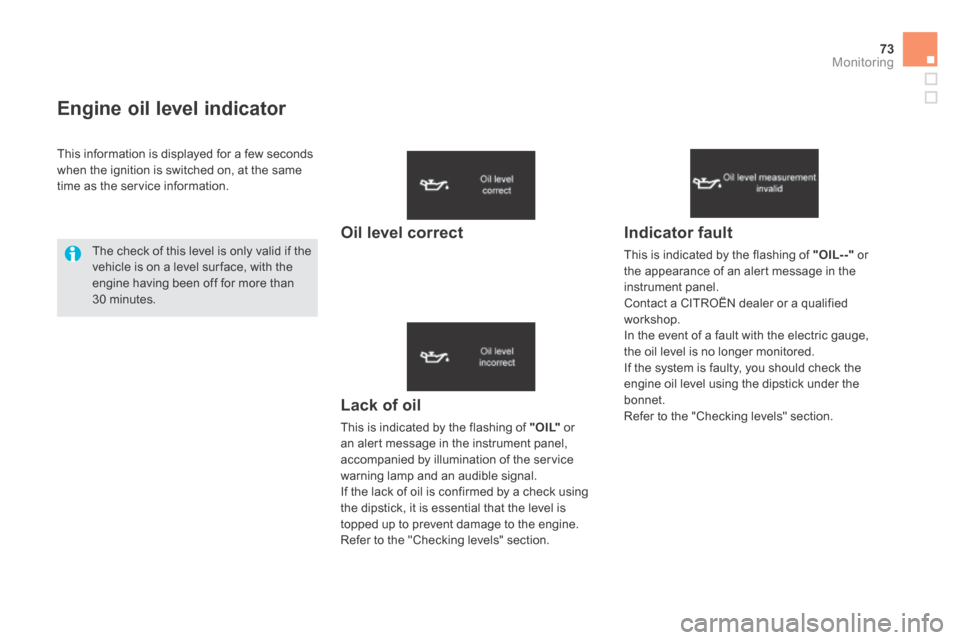
73Monitoring
Engine oil level indicator
Lack of oil
This is indicated by the flashing of " O I L" or an alert message in the instrument panel, accompanied by illumination of the service warning lamp and an audible signal. If the lack of oil is confirmed by a check using the dipstick, it is essential that the level is topped up to prevent damage to the engine. Refer to the "Checking levels" section.
Indicator fault
This is indicated by the flashing of "OIL- -" or the appearance of an alert message in the instrument panel. Contact a CITROËN dealer or a qualified workshop. In the event of a fault with the electric gauge, the oil level is no longer monitored. If the system is faulty, you should check the engine oil level using the dipstick under the bonnet. Refer to the "Checking levels" section.
This information is displayed for a few seconds when the ignition is switched on, at the same time as the service information.
The check of this level is only valid if the vehicle is on a level sur face, with the engine having been off for more than 30 minutes.
Oil level correct
Page 104 of 382
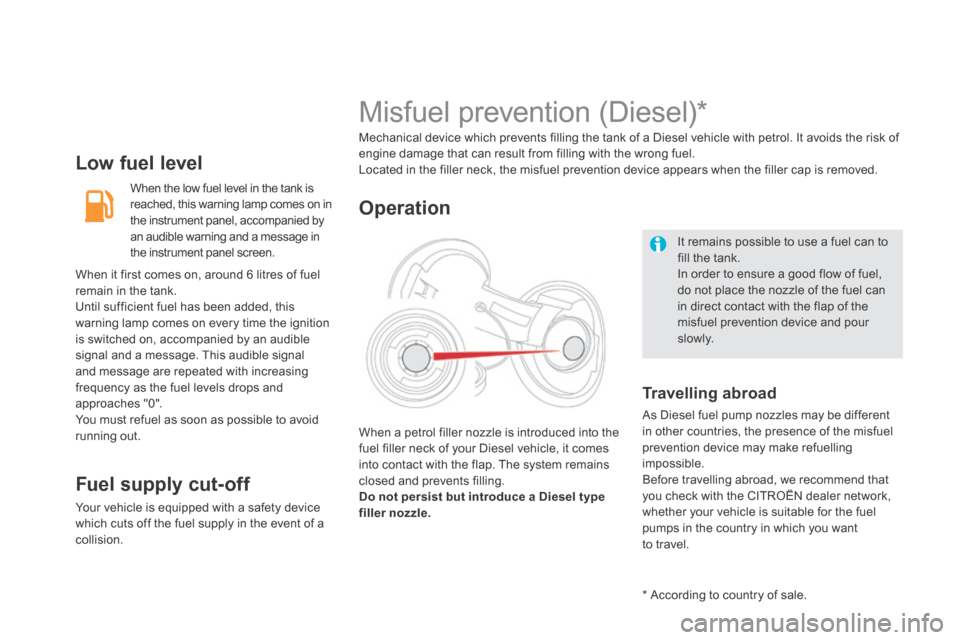
Low fuel level
When the low fuel level in the tank is reached, this warning lamp comes on in the instrument panel, accompanied by an audible warning and a message in the instrument panel screen.
Fuel supply cut-off
Your vehicle is equipped with a safety device which cuts off the fuel supply in the event of a
collision.
It remains possible to use a fuel can to fill the tank. In order to ensure a good flow of fuel, do not place the nozzle of the fuel can in direct contact with the flap of the misfuel prevention device and pour
s l ow l y.
Misfuel prevention (Diesel) *
Mechanical device which prevents filling the tank of a Diesel vehicle with petrol. It avoids the risk of engine damage that can result from filling with the wrong fuel. Located in the filler neck, the misfuel prevention device appears when the filler cap is removed.
When a petrol filler nozzle is introduced into the fuel filler neck of your Diesel vehicle, it comes into contact with the flap. The system remains closed and prevents filling. Do not persist but introduce a Diesel type filler nozzle.
Operation
Travelling abroad
As Diesel fuel pump nozzles may be different in other countries, the presence of the misfuel prevention device may make refuelling impossible. Before travelling abroad, we recommend that you check with the CITROËN dealer network, whether your vehicle is suitable for the fuel pumps in the country in which you want to travel.
* According to country of sale.
When it first comes on, around 6 litres of fuel remain in the tank. Until sufficient fuel has been added, this warning lamp comes on every time the ignition is switched on, accompanied by an audible signal and a message. This audible signal and message are repeated with increasing frequency as the fuel levels drops and approaches "0". You must refuel as soon as possible to avoid running out.
Page 125 of 382
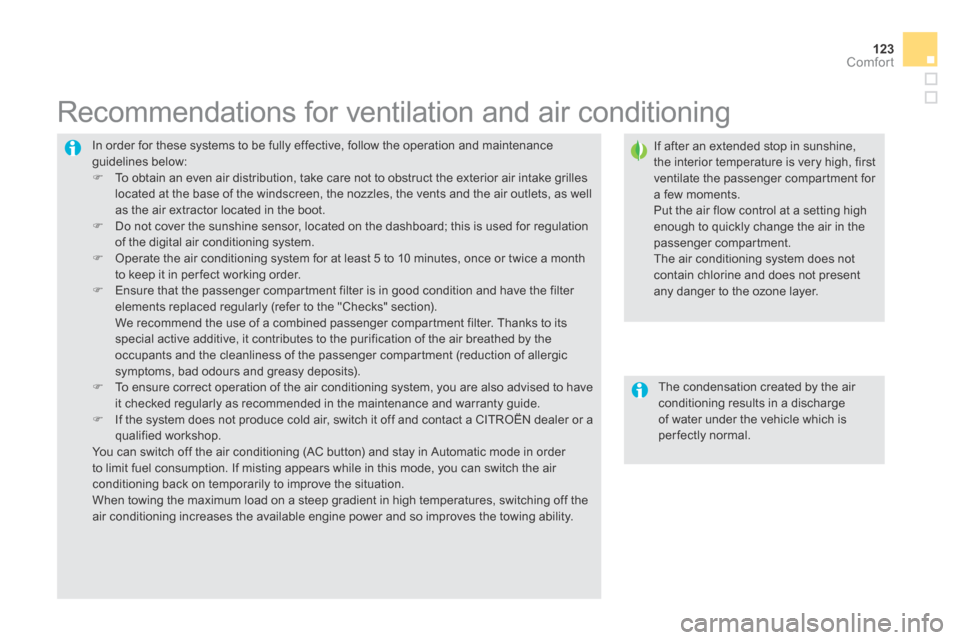
123Comfort
In order for these systems to be fully effective, follow the operation and maintenance guidelines below: To obtain an even air distribution, take care not to obstruct the exterior air intake grilles located at the base of the windscreen, the nozzles, the vents and the air outlets, as well as the air extractor located in the boot. Do not cover the sunshine sensor, located on the dashboard; this is used for regulation of the digital air conditioning system. Operate the air conditioning system for at least 5 to 10 minutes, once or twice a month to keep it in per fect working order. Ensure that the passenger compartment filter is in good condition and have the filter elements replaced regularly (refer to the "Checks" section). We recommend the use of a combined passenger compartment filter. Thanks to its special active additive, it contributes to the purification of the air breathed by the occupants and the cleanliness of the passenger compartment (reduction of allergic symptoms, bad odours and greasy deposits). To ensure correct operation of the air conditioning system, you are also advised to have it checked regularly as recommended in the maintenance and warranty guide. If the system does not produce cold air, switch it off and contact a CITROËN dealer or a qualified workshop. You can switch off the air conditioning (AC button) and stay in Automatic mode in order to limit fuel consumption. If misting appears while in this mode, you can switch the air conditioning back on temporarily to improve the situation. When towing the maximum load on a steep gradient in high temperatures, switching off the air conditioning increases the available engine power and so improves the towing ability.
Recommendations for ventilation and air conditioning
If after an extended stop in sunshine, the interior temperature is very high, first ventilate the passenger compartment for a few moments. Put the air flow control at a setting high enough to quickly change the air in the passenger compartment. The air conditioning system does not contain chlorine and does not present any danger to the ozone layer.
The condensation created by the air conditioning results in a discharge of water under the vehicle which is per fectly normal.